Welcome to the second instalment of 7 String Guitar Chords! Hopefully you’ve already seen part one by Joe. His 7 string chord lesson used ‘Drop A’ tuning. However in this 7 string chord lesson we’re just going to be using standard 7 string tuning which is B E A D G B E.
If you don’t have a 7 string guitar, don’t worry. All of these chords sound great on 6 string too. You can just leave out the low B string if you don’t have one. We’ll clearly show you the interval construction of each chord so that if you really know your intervals you’ll be able to re-voice the chord for 6 string.
A lot of these 7 string guitar chords will use open strings. Open strings facilitate a big sound and in some cases let you use all 7 strings. The low B string definitely gives a chord more balls and helps to chunk it up for a fatter sound. Let’s get into it!
eBook for This Lesson: Patron Exclusive
Strings of Rage™ syndicate member patrons get exclusive axe-cess to the ebook for this lesson. Print copies can also be requested.
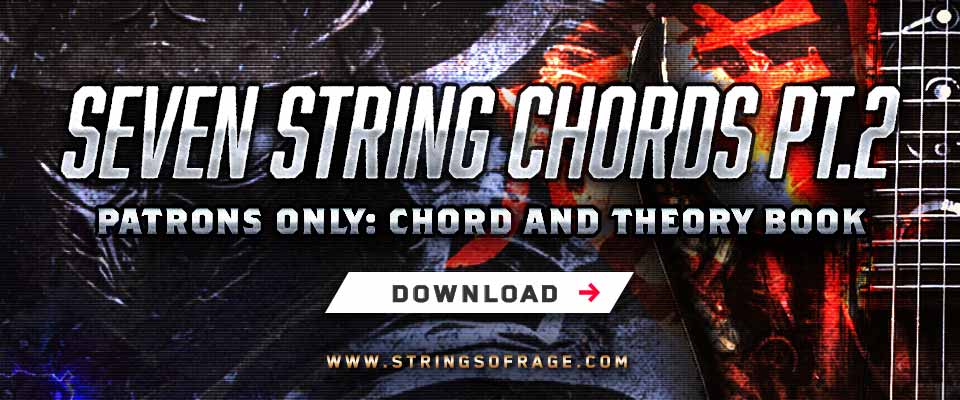
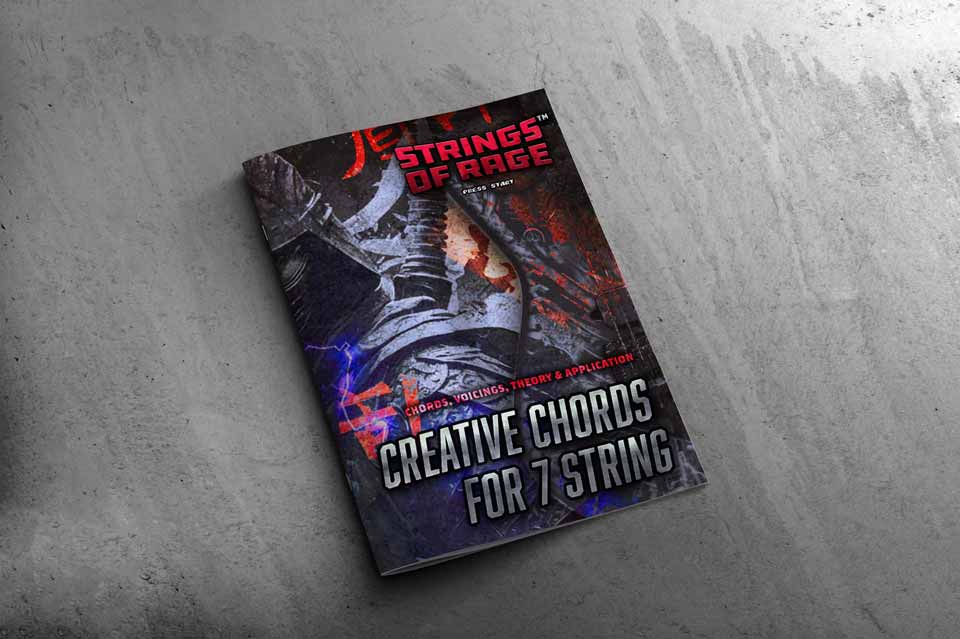

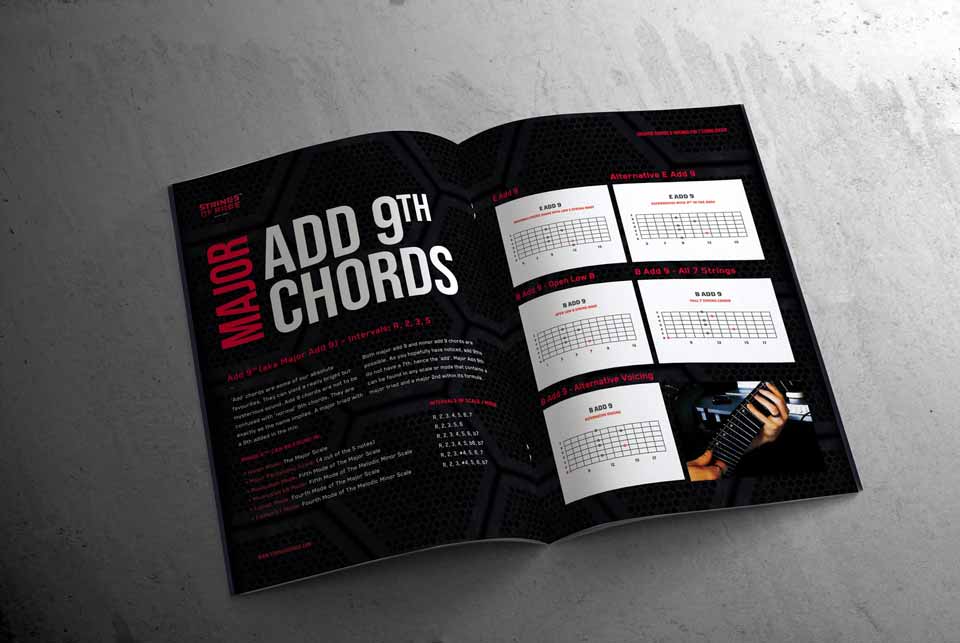

Contents for This Lesson:
Use these links to jump to the section of interest or start from the top to cover everything.
01: Intervals & Context →
02: Major 7th Chords →
03: Major & Minor 9th Chords →
04: Add 9th Chords →
05: Add 9 Add 11 Chords →
06: Major 13th Chords →
07: Suspended Chords →

7 String Guitar Chords: Intervals and Context
For each of the chords in this lesson we’ll show you the intervals that make up these chords as well as some basic theory on where these chords can be derived and used. Without context it can be difficult to know where or how to use these ideas. Some of these chords could easily come from multiple keys. Hopefully you can use your knowledge to work these ideas into your own chord progressions!
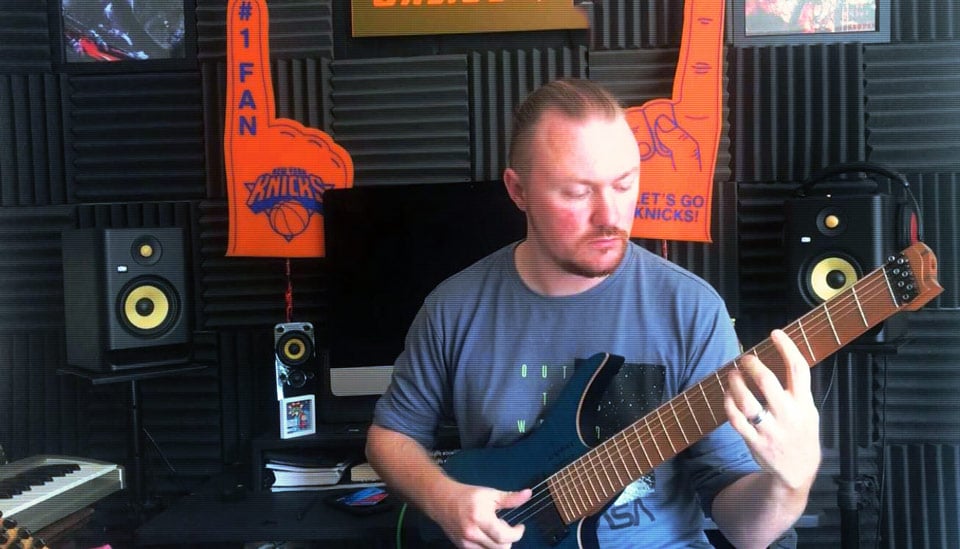
7 String Guitar Shell Voicings: Omitting The Fifth
It’s worth mentioning that with any chords larger than a triad, you can actually leave out the fifth. A fifth interval is very much a ‘neutral’ type of sound and doesn’t provide much harmonic substance or ‘colour’ to the chord. When you omit the fifth from a chord (with the exception of triads) this yields a ‘shell voicing’. Shell voicings only contain the most important intervals of a chord that form the sound. For example, a major 7th shell voicing would consist of Root, Major 3rd, Major 7th. Equally a Minor 9th would contain Root, Major 2nd, Minor 3rd, Minor 7th.
7th chords as shell voicings are only 3 notes. You might say, why aren’t these triads? While they are three notes, it’s the intervals that are important here. It’s simply because we’ve omitted the fifth.
Exploring shell voicings can lead to some interesting chord shapes and fingerings you might not have otherwise thought of if you’re trying to always include the fifth. Do experiment.
A great advocate of this is the great Ted Greene and we’d highly recommend his book chord chemistry.
Moveable 7 String Chords & Shapes
A few examples in this lesson are ‘moveable’ chord shapes. A ‘moveable’ shape is a chord shape that you can move up and down the neck and the chord type remains the same. It’ll just become a different root note. Moveable chord shapes can be great for creating modern sounding chord progressions, even simple two chord vamps.
A lot of chords are not moveable however, especially those that use open strings.

Major 7th – Intervals: R, 3, 5, 7
Major 7th Chords are the bread and butter of almost every guitar players chord arsenal. However with the right chord voicing you can achieve a really modern sound. One way to do this with major 7th chords is simply to take a movable voicing and move it up and down in major or minor thirds. Even a two chord vamp like this can be very modern and prog sounding.
Major 7ths can be derived from any scale who’s formula has the above intervals.
Major 7ths can be found in:
- Ionian Mode (Major Scale)
- Lydian Mode – Fourth Mode of The Major Scale
- Lydian #2 Mode – Sixth Mode of The Harmonic Minor Scale
- Lydian Augmented (shell voicing only no fifth) – Third Mode of Melodic Minor
Rootless Chords for 7 String Guitar
It’s worth mentioning that rootless chords are usually inversions of other chords. The above example could also be an inversion of B minor. Of course Bminor would be different intervals but the same notes. If you voice your chords correctly, even without a root they can still sound like the desired chord. The idea with rootless chords is that you have one or more other instruments playing the root. The obvious choice being the bass player.

Major 9th – Intervals: R, 2, 3, 5, 7
As the name implies, this is a major triad with the additional scale extensions of a major 2nd (also known as a 9th above the octave) and also a major 7th. You can derive a major 9th chord from quite a few different places. Generally though, if a scale or mode has the above intervals, a major 9th will be possible from that root.
Three obvious places you can derive a major 9th chord are:
- Ionian Mode (The Major Scale)
- Lydian Mode – (Fourth Mode of The Major Scale)
- Lydian Augmented (shell voicing only no fifth) – Third Mode of Melodic Minor
Minor 9th – Intervals: R, 2, b3, 5, b7
Minor 9th is a really great sound, especially voiced like these. Be aware of the intervals! Even though this is a minor chord, it has a major 2nd interval. You can derive this sound from any scale that has the intervals R, 2, b3, 5, b7. This means you could work this chord into a progression from these scales.
For example:
- Dorian Mode – Major Scale Mode
- Aeolian Mode – Major Scale Mode
- Locrian #2 – Melodic Minor Mode (shell voicing omitting the 5th)
- Dorian #4 – Harmonic Minor Mode

Add 9 (major add 9) – Intervals: R, 2, 3, 5
Add 9 chords are not to be confused with ‘normal’ 9th chords. They are exactly as the name implies.
A major triad with a 9th added in the mix. Both major add 9 and minor add 9s are possible. As you hopefully have noticed, add 9ths do not have a 7th.
Major Add 9th can be found in any scale or mode that contains a major triad and a major 2nd within its formula.
Examples Include:
- Ionian Mode (Major Scale)
- Major Pentatonic Scale (4 out of the 5 notes)
- Mixolydian Mode – Fifth Mode of The Major Scale
- Mixolydian b6 Mode – Fifth Mode of The Melodic Minor Scale
- Lydian Mode – Fourth Mode of The Major Scale
- Lydian b7 Mode – Fourth Mode of The Melodic Minor Scale
Alternative 7 String Voicing With 3rd In The Bass

(Major) Add 9 Add 11 Chords – Intervals: R, 2, 3, 4, 5 or R, 3, 5, 9, 11
These 5 note chords add yet another note into the mix. We simply take our add 9 chord and add the 11 into the mix as well. The 11 is the same as the 4 just above the octave of the root. If it’s easier, you can think of these as Add 2 Add 4 but written down, they’re most commonly referred to as Add 9 Add 11. Once again there’s no major 7th with these chords which is why these are not considered major 11th.
Add 9 Add 11 Chords Can be derived from any scale that has the above intervals in its scale formula.
- Ionian Mode (Major Scale)
- Mixolydian Mode – Fifth Mode of The Major Scale
- Mixolydian b6 Mode – Fifth Mode of The Melodic Minor Scale

Major 13th Shell Voicing – Intervals: R, 3, 6, 7
When you start getting into extended upper extension chords like 11ths and 13ths they can become tricky to play on guitar because of the amount of notes in the chords. To get over this we can omit the less important intervals and just leave the intervals that really define the sound of the chord. We’ll leave out the 4th and the 5th since those intervals are known as perfect intervals and don’t add the ‘colour’ to a chord.
The most important intervals of 13th chords are the 3rd, the 6th (13th) and the 7th. You’ll know from triads that the 3rd defines the quality of the chord, wether it’s major or minor. Since this is a major 13th chord we’ll also need to add the major 6th (13th above the octave of the root) and major 7th.
Major 13th Chords can be derived from any scale or mode that has the above intervals in it’s formula.
Examples Include:
- Ionian Mode (Major Scale)
- Ionian #5 Mode (3rd Mode of Melodic Minor)
- Lydian Mode (Fourth Mode of The Major Scale)
- Lydian #2 Mode (Sixth Mode of The Harmonic Minor)
13th and 6ths Chords for 7 String Guitar: Whats the difference?
It’s important to not confuse 13th chords with 6th chords. Technically a 13th is just a 6th above the octave of the root and is the same interval as a 6th. However be advised that 6th chords DO NOT contain a 7th and thus is the difference between a 13th chord and a 6th chord.
For example C6 = C, E, G, A whereas C major13 = C, E, G, B, (D), (F), A

Sus 2 #11 – The Lydian Sound – Intervals: R, 2, #4, 5
With sus chords we omit the 3rd and replace with either some type of 2nd or 4th. Sus, meaning ‘suspended’ as in, we’ve suspended the 3rd. This yields an ambiguous sound to begin with purely because there’s no 3rd. In this example though we’re going to add in the #4th from the Lydian mode. Using the open low B string this is a really nice full sounding 7 string chord.
eBook for This Lesson: Patron Exclusive
Strings of Rage™ syndicate member patrons get exclusive axe-cess to the ebook for this lesson. Print copies can also be requested.




Final Closing Thoughts
We couldn’t have begun to even piece these chords together had we not really nailed down our knowledge of intervals. It would have been seemingly impossible, or at the least, very hard to have formulated these chords by knowing only complete scale shapes.
Internalise the intervals. Achieve Ultimate Fretboard Awareness. No Secrets. Just Dedication.
Do It.

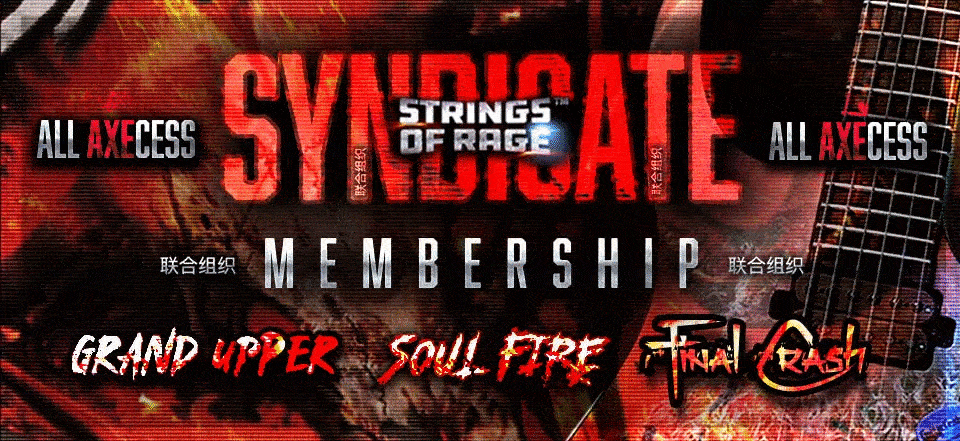
Join The Strings of Rage Syndicate!
Take your guitar playing to the next level. Join the community for exclusive new lessons, ideas and over the top guitar creativity! We look forward to seeing you around!
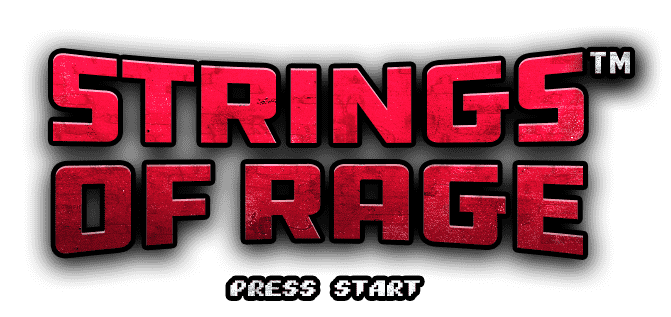
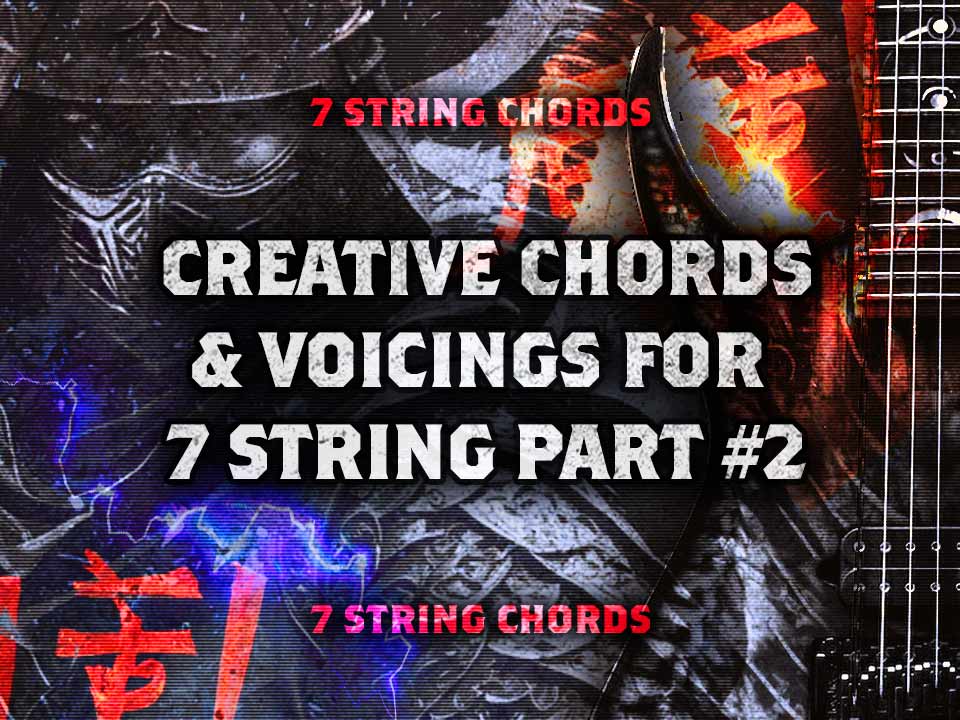


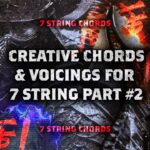


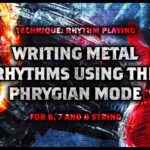
No Comment